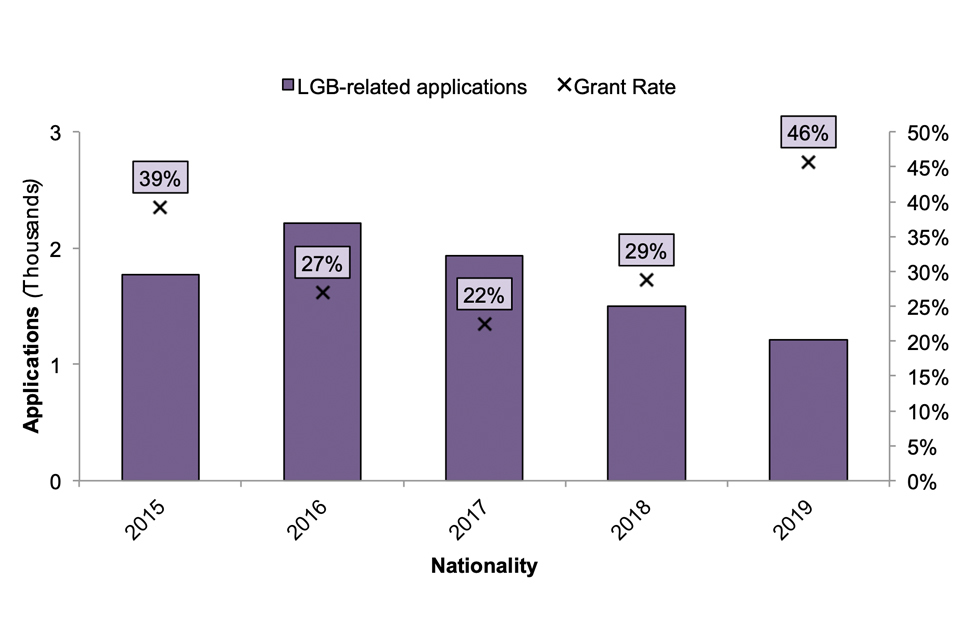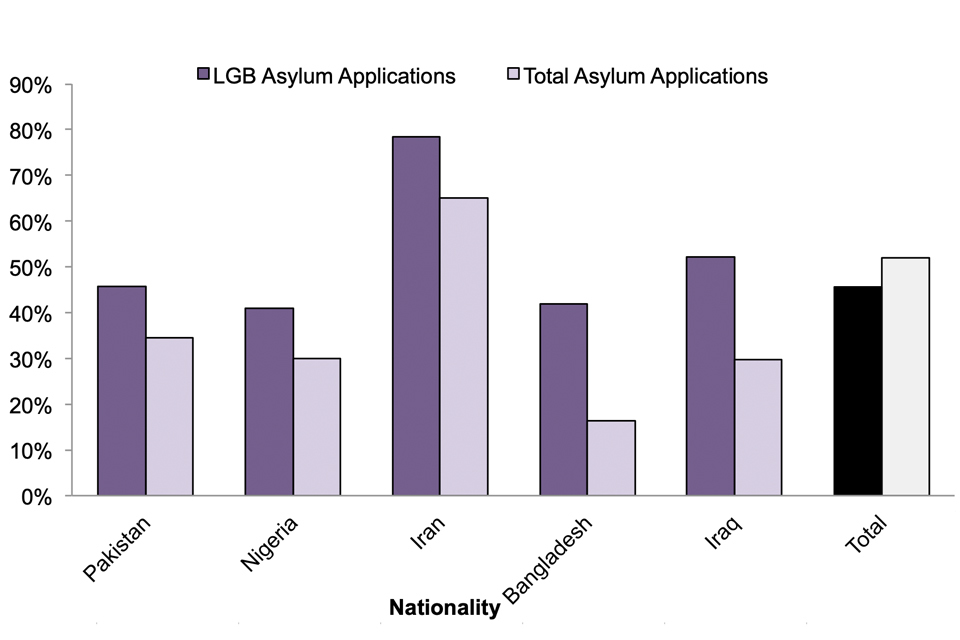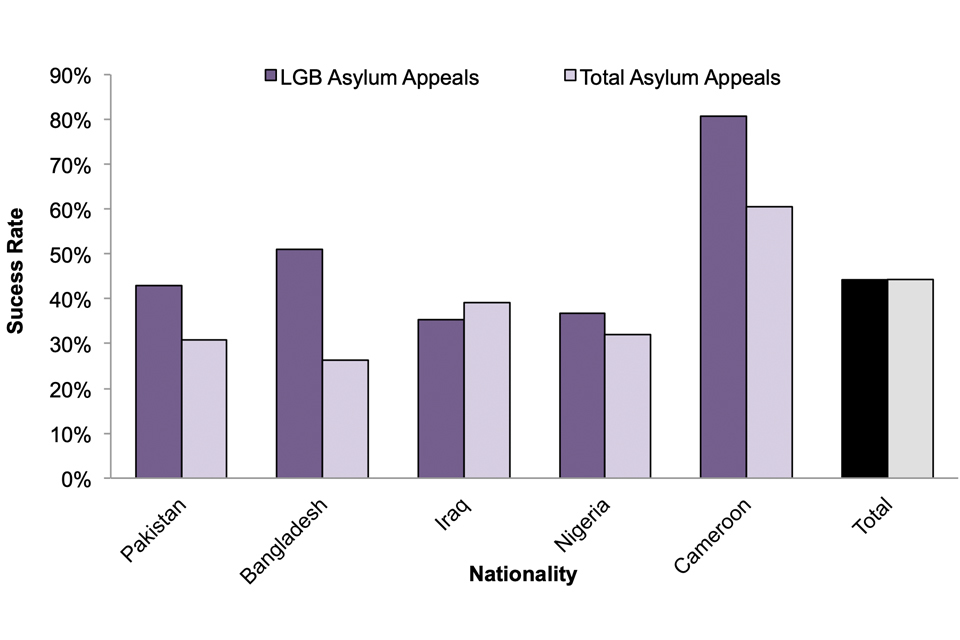EXPERIMENTAL STATISTICS Asylum claims on the basis of sexual orientation
Updated 24 September 2020
Back to ‘Immigration statistics, year ending June 2020’ content page.
This is not the latest release. View latest release.
These statistics are released as Experimental Statistics, meaning they are going through development and evaluation. The Home Office is continuing to work to improve these statistics to ensure they meet the needs of users. Further details can be found in the Office for National Statistics Guide to Experimental Statistics. Additional information about the limitations of these statistics can be found in the ‘about the statistics’ section below.
All statistics published in this section relate to the number of asylum claims made where sexual orientation formed part of the basis of the claim. The data cover claims with a lesbian, gay, or bisexual (LGB) element, but do not cover other forms of sexual or gender identity.
1. Asylum applications
Data in this section refer to asylum applications from main applicants made in 2019.
There were 1,212 asylum applications lodged in the UK in 2019, where sexual orientation formed part of the basis for the claim (LGB asylum applications), representing 3% of all asylum applications. This is a decrease of 19% in these types of application compared to the previous year. In contrast, total asylum applications increased by 21% over the same period. The fall in LGB asylum applications could be down to a number of factors. Changes from year-to-year and the recording of LGB related cases in the asylum system are unlikely to indicate a change in the level of risk for LGB people globally.
Figure 1: Asylum applications lodged in the UK where sexual orientation formed part of the basis for the claim, and the grant rates on such applications, years ending December 2015 to December 2019

.
Notes:
- Includes main applicants only.
- Grant rate is the proportion of initial decisions which resulted in a grant of protection or other leave. Grant rate is based on year of initial decision and is not directly comparable to applications, which are based on the date the asylum application was made.
Pakistani nationals have accounted for the largest number of LGB asylum applications in each of the last five years (between 20% and 30%), but their number fell by 26% in the latest year to 240 (compared with a 5% decrease in all Pakistani asylum applications). There were also large falls in LGB asylum applications from Bangladeshi nationals, down 32% to 101 (compared with a 11% decrease in all Bangladeshi asylum applications). On the other hand, LGB applications from Nigerian nationals saw a larger increase of 47%, rising to 132 in the latest year (compared with a 12% increase in all Nigerian asylum applications).
Figure 2: Top 51 nationalities lodging asylum applications2 where sexual orientation3 formed part of the basis for the claim, as a proportion of total asylum applications, 2019

.
Source: EXPERIMENTAL STATISTICS: Asylum claims on the basis of sexual orientation -Table SOC_01 and Asylum applications, initial decisions and resettlement – Asy_D01
Notes:
- Top 5 nationalities presented are those with the highest numbers of asylum applications where sexual orientation formed part of the basis for the claim in 2019.
- Includes main applicants only.
- Sexual orientation claims cover claims with a lesbian, gay, or bisexual (LGB) element, but do not cover other forms of sexual or gender identity.
For most nationalities, LGB asylum applications account for a small proportion of total asylum applications. However, although numbers are relatively small, just under half of all applications received from Ugandan (43%) and Malaysian (40%) nationals had a sexual orientation element.
Table 1: Top 51 nationalities with the highest proportion of asylum applications2 where sexual orientation formed part of the basis for the claim, 2019
| Nationality | Asylum claims based on sexual orientation | Total asylum claims | % of claims based on sexual orientation |
|---|---|---|---|
| Uganda | 55 | 128 | 43% |
| Malaysia | 80 | 200 | 40% |
| Namibia | 62 | 436 | 14% |
| Nigeria | 132 | 937 | 14% |
| Pakistan | 240 | 1,937 | 12% |
Source: EXPERIMENTAL STATISTICS: Asylum claims on the basis of sexual orientation -Table SOC_01 and Asylum applications, initial decisions and resettlement – Asy_D01
Notes:
- Nationalities presented are those with the highest percentage of total applications based on sexual orientation, and who had at least 50 LGB asylum applications in 2019.
- Main applicants only.
2. Initial Decisions
Data in this section refer to initial decisions made on asylum applications in the calendar years 2019. Decisions may relate to an application made in an earlier year, and therefore are not directly comparable with applications over the same period.
There were 464 grants of asylum or an alternative form of leave to main applicants where sexual orientation formed part of the basis for their asylum claim in 2019. This was 7% fewer than the previous year. Not all of these will necessarily have been granted protection on the basis of the sexual orientation element of the claim.
The proportion of initial decisions on LGB asylum applications which resulted in a grant of protection or other leave decreased between 2015 and 2017, from 39% to 22%, but has increased over the past two years, and almost half (46%) of LGB asylum applications were granted in 2019, mainly as a result of a large fall in refusals. The recent increase in grant rate for LGB applications is broadly in line with the increase in overall grant rate in all asylum decisions over the last couple of years, which rose from 32% in 2017 to 52% in 2019. Changes in the number of grants and refusals can be impacted by a number of factors, including the way in which cases are prioritised within the asylum system.
Although the grant rate for LGB asylum applications (46%) was lower than for all asylum applications (52%) in 2019, nationalities who more commonly claim asylum on the basis of sexual orientation typically see higher grant rates for LGB applications than for total applications (see Figure 3).
Overall the success rate for claims recording a sexual orientation element does not differ greatly from the overall grant rate for asylum applications, with nationality of the applicant typically proving a more influential factor than any sexual orientation element to their application.
Figure 3: Grant rates at initial decision1 on asylum claims where sexual orientation formed part of the basis for the claim, by nationality2, 2019

.
Source: EXPERIMENTAL STATISTICS: Asylum claims on the basis of sexual orientation -Table SOC_02 and Asylum applications, initial decisions and resettlement – Asy_D02
Notes:
- Main applicants only.
- Nationalities are those with at least 50 initial decisions made on asylum claims with a sexual orientation basis over the period.
3. Appeals
Data in this section on appeals received refer to appeals from main applicants which were lodged in the calendar year 2019. Data on determinations of appeals refer to appeal decisions which were made in the calendar year 2019 and may relate to an appeal lodged in a prior year. Therefore, data on appeals determined are not directly comparable with appeals received over the same period.
There were 565 appeals relating to asylum applications where sexual orientation formed part of the basis for the claim lodged in the UK, representing 6% of all appeals lodged in this period.
There were 52% fewer appeals lodged relating to LGB asylum applications in the last year, 565 in 2019 compared to 1,170 in 2018. The fall in appeals reflects the fall in the number of LGB asylum applications refused at initial decisions over the same period (from 1,244 to 553). Prior to 2018, the number of appeals had increased, but this is likely to reflect, in part, improvements from caseworkers in the use of the sexual orientation identifier from 2015. As some cases can take a long time to reach the appeals stage, some of the appeals may relate to claims made in earlier years when the flag was not widely used.
In 2019, less than half (44%) of appeals relating to LGB asylum applications were allowed. This was the same as the appeal success rate for all asylum applications. However, as with the trend observed for grant rates at initial decision, the nationalities who commonly claim asylum on the basis of sexual orientation typically had a higher appeal success rate for LGB-related asylum claims compared to the success rate for all claims (see Figure 4).
Figure 4: Success rates on appeals following asylum claims where sexual orientation formed part of the basis for the claim, by nationality, 2019

.
Source: EXPERIMENTAL STATISTICS: Asylum claims on the basis of sexual orientation -Table SOC_04 and Asylum appeals lodged and determined – Asy_D07
Notes:
- Main applicants only.
4. About the statistics
Applicants are not required to disclose their sexual orientation when applying for asylum. Some individuals may have less reason to mention sexual orientation when making a claim because it may not be a significant factor in their seeking asylum. Such nationalities would be undercounted in these statistics. These statistics also reflect the claims made by asylum applicants and do not reflect a confirmed sexual orientation of the applicant.
The data give information on asylum claims, initial decisions, and appeals where sexual orientation was raised as part of the basis for the claim at some stage prior to reaching a final outcome. The sexual orientation element could be raised at any stage of the process (for example, as part of the asylum case, appeal, or as part of other casework), and may form either the sole basis, or one of multiple grounds for the claim. It may or may not have been accepted as a valid part of the claim, so the data do not necessarily reflect the reason for an initial decision or appeal outcome.
Like other data derived from administrative data, these numbers are correct as at the time of data extraction and may be updated in subsequent statistics releases.
Data on sexual orientation were not routinely recorded in a reportable format prior to 2015. This means that sexual orientation claims that were raised before 2015 that had an initial decision in 2015 or later may not be counted in the initial decisions data (unless the flag was raised in 2015 or later). Similarly, an appeal relating to an application raised prior to 2015 may not be included in the data if the sexual orientation element was raised before 2015. Therefore, the number of initial decisions and appeals will be an undercount. This will affect earlier years to a greater extent than more recent years, so trends over time should be interpreted with caution.
Caseworkers use of the sexual orientation flag is likely to have improved in recent years. However, users should exercise caution when making comparisons over time, as the data could be impacted by recording practices.
Falls in the number of applications, decisions and appeals will be impacted by a range of factors, including the recording practices of decision-makers on caseworking systems. Further, if applications where LGB is mentioned by the applicant or appellant at some point in the process have dropped, then subsequent LGB-related outcomes are likely to drop too. The way cases are prioritised can also impact the number of decisions made on particular cases over a particular period of time. For example, if a greater number of historic cases (prior to when the LGB flag was widely used) are resolved, the statistics are likely to show fewer LGB cases.
The statistics show:
- The number of asylum claims where sexual orientation was raised as a basis, or part of the basis, of the claim
- The initial decision of claims where sexual orientation was raised as part of the claim
- The number of appeals received for asylum cases where sexual orientation was raised as part of the claim
- The outcome of appeals for asylum cases where sexual orientation was raised as part of the claim
The statistics do not show:
- Whether sexual orientation was the sole basis for the asylum claim
- Whether sexual orientation was raised as the basis of the asylum claim at the time the claim was made, or whether it was raised at a later stage (such as at appeal)
- Whether the sexual orientation element of the claim has any bearing on the outcome. For example, a claim may be based on multiple factors. The outcome of the claim may or may not be due to the sexual orientation element
- The number of asylum claimants who define themselves as LGB. Having an identifier that an asylum case is based on sexual orientation does not indicate that a claimant has any particular sexual orientation. It also does not signify whether that aspect of the claim has been accepted. Sexual orientation as a basis of claim could be due to imputed assertions or association rather than a defining characteristic of the claimant
- Whether the sexual orientation element of the claim had any bearing on the appeal being lodged, or the outcome of the appeal
- Any individuals at risk of persecution due, in part or in full, to a sexual orientation component who have been granted protection through other routes, such as resettlement routes
5. Data tables
Data referred to here can be found in the following tables:
6. Experimental Statistics
These statistics are designated as ‘Experimental’. Although the statistics in their current form have undergone a strict quality assurance process, the limitations are well understood (and outlined above) and improved guidance provided to caseworkers who record the information leads us to believe the data are robust, these statistics remain under review.
The Home Office is planning to introduce a new asylum caseworking system. This may affect the information reported in this section. Therefore, the information reporting in the LGB section will remain experimental until these developments are fully understood.
We welcome your feedback
If you have any comments or suggestions for the development of this report, please provide feedback by emailing MigrationStatsEnquiries@homeoffice.gov.uk. Please include the words ‘PUBLICATION FEEDBACK’ in the subject of your email.
We’re always looking to improve the accessibility of our documents. If you find any problems or have any feedback relating to accessibility, please email us.
See section 7 of the ‘About this release’ section for more details.
